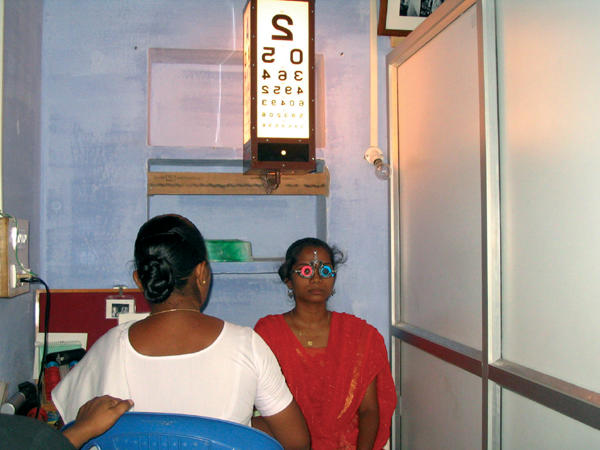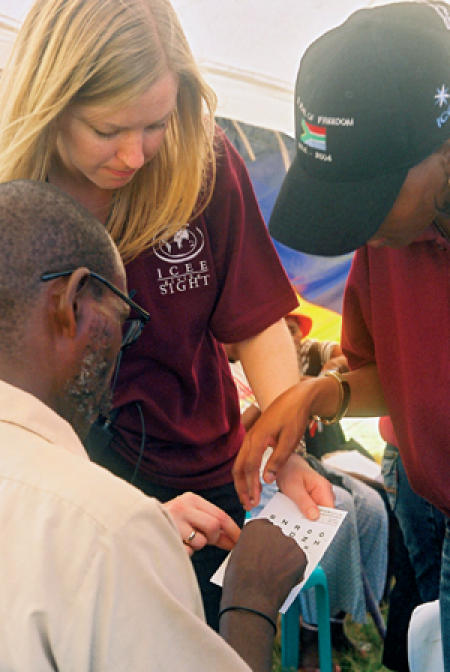
In the late 1990s, two papers from very different parts of the world, Australia and India, highlighted the fact that uncorrected refractive error was a significant cause of blindness and the major cause of impaired vision.1,2 Since then, the World Health Organization (WHO) and the International Agency for the Prevention of Blindness (IAPB), both separately and in their joint initiative, VISION 2020: The Right to Sight, have worked very hard to put uncorrected refractive error on the blindness prevention agenda and to develop strategies for the elimination of this most simple avoidable cause of vision loss. They have been joined in these efforts by international non-governmental development organisations with expertise or programmes in this field, such as the International Centre for Eyecare Education (ICEE), Sightsavers International (SSI), Christian Blind Mission (CBM), Helen Keller International (HKI), and the World Councilof Optometry (WCO).

A patient undergoes refraction. INDIA
WHO revealed the magnitude of the problem on World Sight Day, October 12, 2006, when it released its findings about the prevalence of uncorrected refractive error: 153 million people are either blind or visually impaired due to uncorrected distance refractive error.
Commenting on the importance of uncorrected refractive error, the WHO Assistant Director General, Dr Catherine Le Gales-Camus, said: “These results reveal the enormity of the problem. This common form of visual impairment can no longer be ignored as a target for urgent action.” She also stressed the link between uncorrected refractive error and poverty: “Without appropriate optical correction, millions of children are losing educational opportunities and adults are excluded from productive working lives, with severe economic and social consequences. Individuals and families are frequently pushed into a cycle of deepening poverty because of their inability to see well.”3
Adding the number of people who are blind and visually impaired due to uncorrected refractive error to those blind and visually impaired due to eye disease has virtually doubled the figures for the global burden of blindness and visual impairment (Table 1).
Table 1.
Resources required for optical services through outreach
| number of people (millions) | ||||||
|---|---|---|---|---|---|---|
| Permanent vision loss | Correctable vision loss | Total | ||||
| Vision loss due to eye disease | ||||||
| Blind | No light perception | 7 | - | 7 | ||
| Blind | Vision from <3/60 to light perception in the better eye | 15 | 15 | 30 | ||
| Visually impaired | Vision from <6/18 to 3/60 in the better eye | 62 | 62 | 124 | ||
| Subtotal | 84 | 77 | 161b | |||
| Vision loss due to distance refractive error | ||||||
| Blind | Vision from <3/60 to light perception in the better eye | - | 8 | 8 | ||
| Visually impaired | Vision <6/18 to 3/60 in the better eye | - | 145 | 145 | ||
| Subtotal | - | 153 | 153a | |||
| Vision loss due to near refractive error | ||||||
| Visually impaired | Near vision equivalent to <6/18 in the better eye | - | >150 | >150b | ||
| Subtotal | >150 | >150b | ||||
| Total | 84 | >380 | >464b | |||
WHO figures
Those with presbyopia who cannot get access to spectacles may number over 500 million people
The categorisation of overall blindness and visual impairment related to eye disease into treatable and permanent vision loss is an important issue, but one for which definitive analyses and data are not yet available. In the interim, however, for planning purposes, it is important to try to estimate what might be the situation in each category. As outlined in Table 1, the estimates are as follows:
7 million people are totally blind, with no light perception
30 million are blind, with vision ranging from light perception to <3/60 in the better eye; half of these cases may be treatable (e.g. cataract)
124 million are visually impaired (vision <6/18 in the better eye) from eye disease; approximately half of these cases may be treatable, while the rest suffer from permanent visual impairment (i.e. low vision).
With regards to the new figures for uncorrected refractive error released by WHO, it has been estimated that, of the 153 million affected by uncorrected distance refractive error:
8 million are blind
145 million have significant distance visual impairment.
In addition to the 153 million people with vision loss due to distance refractive error, there are hundreds of millions who have severe near vision impairment (near vision equivalent to <6/18 in the better eye) due to uncorrected presbyopia.
Though no definitive data are yet available from WHO on global uncorrected presbyopia, estimates can be made of the range and magnitude of the problem. For example, papers published on uncorrected presbyopia in Africa4 andAsia5 show that in some countries up to94 per cent of people with presbyopia have no vision correction at all. Those who cannot access an eye examination and receive spectacles may therefore number well over 500 million people.6 For the moment, ICEE is using a conservative planning figure of 150 million people with significant near visual impairment due to Uncorrected refractive error causes serious visual problems for children trying to learn and adults trying to work. The urgency of this problem and its unacceptability in today's world was partly the stimulus for the first World Congress on Refractive Error (WCRE) hosted by the ICEE in Durban, South Africa, in March 2007. The congress attracted 650 people from national and international government agencies, professional councils, and international non-governmental develop-ment organisations, who spent four days discussing every aspect of the problem of uncorrected refractive error, as well as potential solutions.

Outreach clinic in Tongaat held the day after the World Congress on Refractive Error. SOUTH AFRICA
The congress resulted in the Durban Declaration,7 which was negotiated and unanimously endorsed by the 650 delegates. These included representatives of the World Council of Optometry (WCO), The International Council of Ophthalmology, IAPB, hosts ICEE, representatives of civil society, and regional and national government ministries and department representatives. The Director General of the Department of Health for South Africa, the honourable Mr Thami Mseleku, said that he was proud that South Africa was chosen as the site for the inaugural WCRE and observed that the congress was “making the world realise that this is a very important commitment to VISION 2020. The resolution shouldn’t just remain on paper – we should talk about how to take it forward.”
And that, of course, is the key: it has become essential to plan and fund the solution to uncorrected refractive error.
In the words of the Durban Declaration7:
“We call upon governments, professional bodies, manufacturers, suppliers, international organisations, and civil society to:
make refractive services a priority
support the development and deployment of appropriate human resources, infrastructure, and technology for the effective delivery of refractive services within the public sector
rationalise the tariffs, duties, and taxes imposed on spectacles, equipment for refraction, and optical laboratory equipment
support and facilitate organisations working towards the elimination of avoidable blindness.”
The world must make every effort to meet the goals of VISION 2020 and eliminate uncorrected refractive error within the next 13 years. A tall order? Not really. ICEE has estimated (based on its own data from Africa, Timor-Leste, and Sri Lanka, as well as on data from the LV Prasad Eye Institute in India) that it will cost US $1,500 million to give 300 million people access to an eye examination by a trained local eye care person and a pair of spectacles.
US $1,500 million for 300 million people to see by 2020 is a small price to pay for eliminating the direct loss of opportunity and productivity due to uncorrected refractive error. Better yet, it will also eliminate the indirect costs of having sighted children with uncorrected refractive errors in programmes for the blind, of uncorrected myopic children failing at school unnecessarily, and of the older needlessly blind and visually impaired depending on society and the community. In total, a saving of many tens of billionsof dollars.
Optometry Giving Sight, a joint initiative of IAPB, WCO, and ICEE, is galvanising optometry professionals and their patients throughout the world into donating a substantial part of the total cost of ‘giving sight’. This initiative has been successfully launched in five countries thus far.
The commitments needed to achievethe ultimate objective of VISION 2020:The Right to Sight for those with uncorrected refractive error, as outlined in the Durban Declaration, include: quantifying vision loss due to uncorrected presbyopia; undertaking the necessary advocacy, knowledge base development, and research needed to deliver best practice service in line with cultural needs; coordination and cooperation to develop a supply of affordable spectacles and the necessary human resources and infrastructure.
If the world cannot eliminate blindness and visual impairment by delivering spectacles to those in significant need, the world is in a sorry state. For that reason alone, we must cooperate, mobilise our resources, and make sure it happens – preferably before 2020.
References
- 1.Dandona L, et al. Burden of moderate visual impairment in an urban population in southern India. Ophthalmol. 1999;106:487–504. doi: 10.1016/S0161-6420(99)90107-0. [DOI] [PubMed] [Google Scholar]
- 2.Taylor HR, et al. Visual impairment in Australia: distance visual acuity, near vision, and visual field findings of the Melbourne Visual Impairment Project. Am J Ophthalmol. 1997;123:328–337. doi: 10.1016/s0002-9394(14)70128-x. [DOI] [PubMed] [Google Scholar]
- 3.WHO press release. Sight test and glasses could dramatically improve the lives of 150 million people with poor vision. Geneva. 2006. Sep 11, [PubMed]
- 4.Patel I, et al. Impact of presbyopia on quality of life in a rural African setting. Ophthalmol. 2006;113(5):728–734. doi: 10.1016/j.ophtha.2006.01.028. [DOI] [PubMed] [Google Scholar]
- 5.Bourne RR, et al. The Pakistan national blindness and visual impairment survey: research design, eye examination methodology and results of the pilot study. Ophthalmic Epidemiol. 2005;12(5):321–33. doi: 10.1080/09286580500230948. [DOI] [PubMed] [Google Scholar]
- 6.Holden B, et al. Vision impairment due to uncorrected presbyopia (in preparation)
- 7.The Durban Declaration. www.icee.org/pdf/Final_FINAL_Declaration.pdf.


